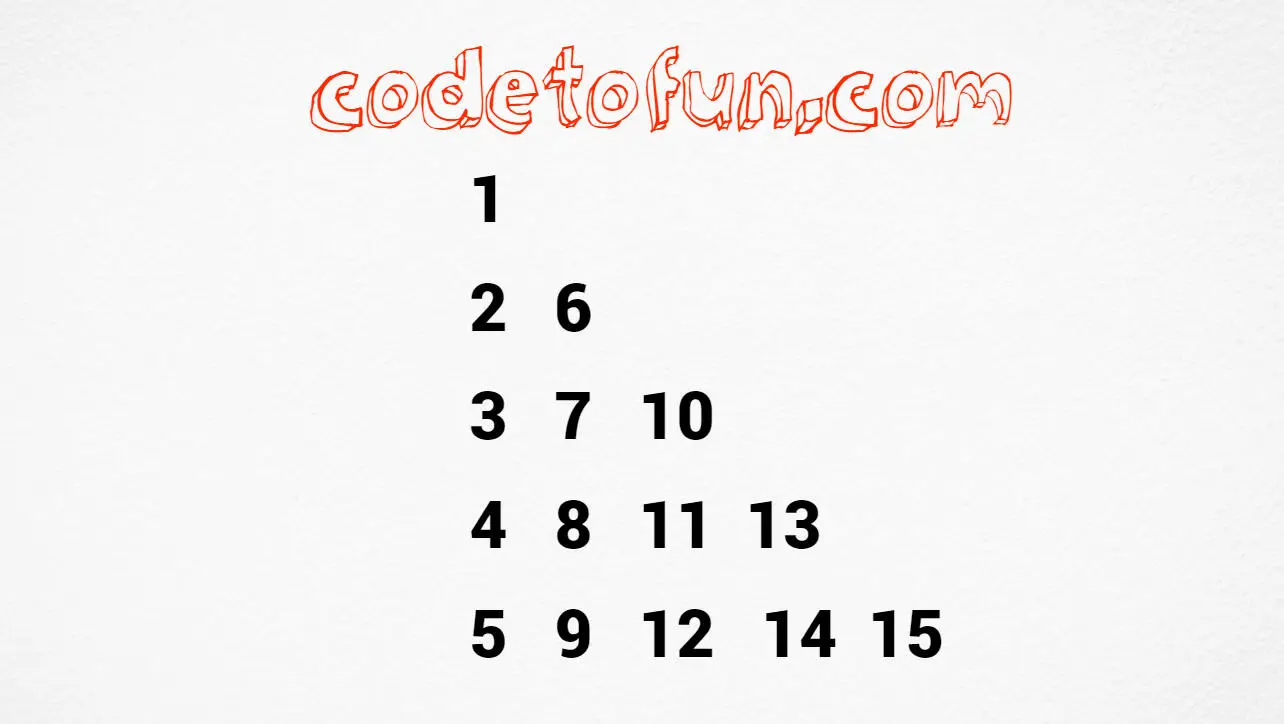
C# Topics
- C# Intro
- C# String Methods
- C# Interview Programs
- C# Star Pattern
- C# Number Pattern
- Number Pattern 1
- Number Pattern 2
- Number Pattern 3
- Number Pattern 4
- Number Pattern 5
- Number Pattern 6
- Number Pattern 7
- Number Pattern 8
- Number Pattern 9
- Number Pattern 10
- Number Pattern 11
- Number Pattern 12
- Number Pattern 13
- Number Pattern 14
- Number Pattern 15
- Number Pattern 16
- Number Pattern 17
- Number Pattern 18
- Number Pattern 19
- Number Pattern 20
- Number Pattern 21
- Number Pattern 22
- Number Pattern 23
- Number Pattern 24
- Number Pattern 25
- Number Pattern 26
- Number Pattern 27
- Number Pattern 28
- Number Pattern 29
- Number Pattern 30
- Number Pattern 31
- Number Pattern 32
- Number Pattern 33
- Number Pattern 34
- Number Pattern 35
- Number Pattern 36
- Number Pattern 37
- Number Pattern 38
- Number Pattern 39
- Number Pattern 40
- Number Pattern 41
- Number Pattern 42
- Number Pattern 43
- Number Pattern 44
- Number Pattern 45
- Number Pattern 46
- Number Pattern 47
- Number Pattern 48
- Number Pattern 49
- Number Pattern 50
- Number Pattern 51
- Number Pattern 52
- Number Pattern 53
- Number Pattern 54
- Number Pattern 55
- Number Pattern 56
- Number Pattern 57
- Number Pattern 58
- Number Pattern 59
- Number Pattern 60
- Number Pattern 61
- Number Pattern 62
- C# Alphabet Pattern
C# Number Pattern 55

Photo Credit to CodeToFun
C# Number Pattern 55
Here`s a program that prints the above number pattern using C# Programming:
using System;
namespace myApp {
class Program {
static void Main(string[] args) {
int i, j, k, res;
for (i = 1; i <= 5; i++) {
k = 4;
res = i;
for (j = i; j < i + i; j++) {
if (i == j)
Console.Write(j + " ");
else {
res = res + k;
Console.Write(res + " ");
k--;
}
}
Console.WriteLine();
}
}
}
}💻 Testing the Program
When you run the above program, it will print the following output:
1 2 6 3 7 10 4 8 11 13 5 9 12 14 15
🧠 How the Program Works
Let's break down the logic behind the code:
- First, we have the necessary using directive: using System;. This line includes the System namespace, which contains the fundamental classes and base classes that define commonly-used value and reference data types, events, event handlers, and interfaces.
- The program is defined within the myApp namespace. Namespaces are used to organize code and avoid naming conflicts.
- The Program class is declared with the static modifier, which means it can be accessed without creating an instance of the class. The program's entry point is the Main method, which is declared static and takes a single parameter of type string[] named args. The Main method is the starting point of execution for the program.
- Inside the Main method, four integer variables are declared: i, j, k, and res. These variables are used in the subsequent loop iterations.
- The program enters a for loop with i starting from 1 and incrementing by 1, until i is less than or equal to 5 (i<=5). This outer loop runs five times.
- Inside the outer loop, k is initialized to 4, and res is set to the current value of i.
- There's an inner for loop with j starting from i and incrementing by 1, until j is less than i+i (j<i+i). The inner loop iterates i times in each iteration of the outer loop.
- Inside the inner loop, there's an if-else condition. If i is equal to j, it means the first iteration of the inner loop is being executed, and it prints the value of j followed by a space to the console. If i is not equal to j, it means it's not the first iteration, and it enters the else block.
- In the else block, res is updated by adding the value of k to it. Then, the updated value of res is printed to the console, followed by a space. After that, the value of k is decremented by 1.
- Once the inner loop is finished, a new line is printed to the console, moving to the next line before starting the next iteration of the outer loop.
- The program continues the outer loop until i becomes 6, at which point the loop terminates.
💯 Tips for Enhancement:
Explore the versatility of this pattern by adjusting its parameters. Whether you increase or decrease the size, tweak the spacing, or modify the characters used, each change opens up a world of possibilities, allowing you to customize and create your unique visual effects.
✔ Conclusion:
Creating visually appealing patterns is not only a fun endeavour but also a great way to enhance your programming or design skills. We hope this tutorial has inspired you to explore the world of creative coding. Share your creations with us, and let your imagination run wild!
🤗 Closing Call-to-Action:
We'd love to see your unique interpretations of the number pattern. Share your creations in the comments below, and don't hesitate to reach out if you have any questions or suggestions for future tutorials. Happy coding!
👨💻 Join our Community:
Author

For over eight years, I worked as a full-stack web developer. Now, I have chosen my profession as a full-time blogger at codetofun.com.
Buy me a coffee to make codetofun.com free for everyone.
Buy me a Coffee












If you have any doubts regarding this article (C# Number Pattern 55) please comment here. I will help you immediately.